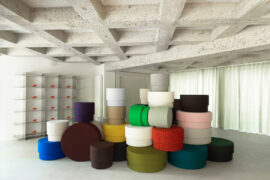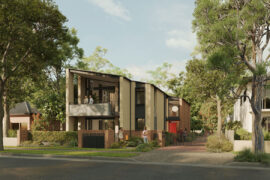The new Sydney workplace for Marsh & McLennan Companies (MMC) is a successful transition from traditional work environment to a Smart Office. The new workplace is the first new working style of its kind for the global company accommodating a variety of work and support areas, located across four floors in Tower 1 of the Barangaroo precinct.
When given the task of transitioning MMC’s workspace from a traditional design to a ‘smart office’ Workplace strategists Aecom (with the aid of PTID) undertook the grand task of conducting numerous workshops, meetings, interviews and utilisation studies to best develop the perfect office design. PTID Designer and Senior Associate Karen Fairfax notes, “As we had worked with MMC on many past projects we already had a deep understanding of their organisation and how they worked, however given their directive to embark on a new Smart Office approach we still needed to delve right in to further understand what this new directive would be. We held detailed workshops with the end users to better understand their future needs and technical requirements so we were sure not to miss anything that was important for the success of the project.” What followed was a rigorous strategy built upon four key principles. “LOOK FORWARD, PULL TOGETHER, CREATE and ADD VALUE” soon became the foundation of the design approach, providing an environment that is transparent, accessible and open and connected, allowing people to easily interact either physically or virtually.
“A Smart Office is not a prescribed solution; rather, it is a way of integrating space sharing, openness, and alternative work settings to achieve the desired benefits. The aim is that more employees will actually come into the office, since a more vibrant, flexible office will provide a better range of work settings for the different needs of interaction and concentration”, states Fairfax. After conducting their studies, workshops and interviews, PTID in collaboration with Workplace strategists Aecom came to develop a cohesive set of principles for the design process ahead.
The outcomes of the workplace strategy survey led the project requirements as follows:
Based on this process PTID developed a ‘kit of parts’, which formed the foundation of the planning principles and the final layout. In finalising the project, the designers took inspiration by the colours of the surroundings of the Barangaroo precinct and Sydney Harbour, paying homage to the iconic Sydney architecture seen translated into some of the patterns on the interior detailing, floor finishes patterns and wall panelling. Fairfax notes, “Our knowledge of the client also helped us to understand their evolving strategies… Backed up by field observation and the Aecom workplace studies a brief was developed that provided an operational framework against which we could develop an environmental experience for all occupants.”
INDESIGN is on instagram
Follow @indesignlive
A searchable and comprehensive guide for specifying leading products and their suppliers
Keep up to date with the latest and greatest from our industry BFF's!

Gaggenau’s understated appliance fuses a carefully calibrated aesthetic of deliberate subtraction with an intuitive dynamism of culinary fluidity, unveiling a delightfully unrestricted spectrum of high-performing creativity.
The new range features slabs with warm, earthy palettes that lend a sense of organic luxury to every space.

The Sub-Zero and Wolf Kitchen Design Contest is officially open. And the long-running competition offers Australian architects, designers and builders the chance to gain global recognition for the most technically resolved, performance-led kitchen projects.

How can design empower the individual in a workplace transforming from a place to an activity? Here, Design Director Joel Sampson reveals how prioritising human needs – including agency, privacy, pause and connection – and leveraging responsive spatial solutions like the Herman Miller Bay Work Pod is key to crafting engaging and radically inclusive hybrid environments.

Take a whirlwind tour of some of the standout appearances at 3daysofdesign 2025.

Featuring designs by Studio Johnston, Sam Crawford Architects, SAHA and others, the NSW Pattern Book for low-rise homes is a milestone in housing design.
The internet never sleeps! Here's the stuff you might have missed

The latest additions to Tappeti’s Gradient Collection explore the emotive power of colour through a series of hand-knotted and hand-tufted rugs.

Unlock your all-access pass to Melbourne’s most exciting day in design.